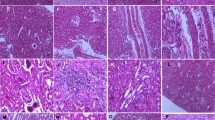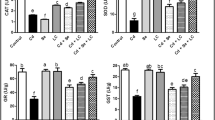Abstract
The present study was carried to evaluate the protective effects of melatonin alone and vitamin E with selenium combination against high dose cadmium-induced oxidative stress in rats. The control group received subcutanous physiological saline. The first study group administered cadmium chloride (CdCl2) by subcutaneous injection of dose of 1 mg/kg. The second study group administered cadmium plus vitamin E with selenium (1 mg/kg sodium selenite with 60 mg/kg vitamin E); the third study group administered cadmium plus 10 mg/kg melatonin (MLT); the fourth study group administered CdCl2 plus a combination of melatonin in addition to vitamin E and selenium for a month. Determination levels of plasma malondialdehyde (MDA), glutathione peroxidase (GSH-Px), blood superoxide dismutase (SOD), creatinine alanine transaminase (ALT), aspartate aminotransferase (AST), alkaline phosphatase (ALP), blood urea nitrogen (BUN), and urea were measured in serum. In only CdCl2 administered group, the MDA, creatinine, ALT, AST, ALP, and urea levels in the serum were significantly higher than the control group (p < 0.05). Whereas in all other groups, this values were significantly lower than the only CdCl2 administered group (p < 0.05). Erythrocytes GSH-Px, serum SOD activities of only CdCl2 received group were significantly lower than the control group (p < 0.05). In conclusion, vitamin E + Se, melatonin and vitamin E, and Se, in addition to MLT combinations, had protective effects against high dose cadmium-induced oxidative damage.
Similar content being viewed by others
References
Robarts K, Worsfold P (1991) Cadmium: Toxicology and analysis, a review. Analyst 116:549–568
World Health Organization, Environmental Health Criteria.134 (1992) Cadmium. IPCS, Geneva
Chan HM, Cherian MG (1992) Protective role of metallothionein and glutathione in hepatotoxicity of cadmium. Toxicology 72:281–290
Stohs SJ, Bagchi D, Hassoun E, Bagchi M (2001) Oxidative mechanisms in the toxicity of chromium and cadmium ions. J Environ Pathol Toxicol Oncol 20:77–88
Sarkar S, Yadav P, Bhatnagar D (1998) Lipid peroxidative damage on cadmium exposure and alterations in antioxidant system in rat erythrocytes: a study with relation to time. Biometals 11:153–157
Koizumi T, Shirakura G, Kumagai H, Tatsumoto H, Suzuki KT (1996) Mechanism of cadmium-induced cytotoxicity in rat hepatocytes: cadmium-induced active oxygen-related permeability changes of the plasma membranes. Toxicology 114:125–134
Manca D, Ricard AC, Trottier B, Chevalier G (1991) Studies on lipid peroxidation in rat tissues following administration of low and moderate doses of cadmium chloride. Toxicology 67:303–323
Kara H, Karatas F, Canatan H, Servi K (2005) Effects of exogenous metallothionein on acute cadmium toxicity in rats. Biol Trace Elem Res 104:223–232
Bagchi D, Bagchi M, Hassoun E, Stohs SJ (1996) Cadmium-induced excretion of urinary lipid metabolites, DNA damage, glutathion depletion and hepatic lipid peroxidation in Sprague–Dawley rats. Biol Trace Elem Res 52:143–154
Casalino E, Sblano C, Calzaretti G, Landriscina C (2006) Acute cadmium intoxication induces alpha-class glutathione S-transferase protein synthesis and enzyme activity in rat liver. Toxicology 217:240–245
Hussain T, Shukla GS, Chandra FS (1987) Effects of cadmium on supeoxide dismutase and lipid peroxidation in liver and kidney of growing rats: in vivo and in vitro studies. Pharmacol Toxicol 60: 355–358
Eybl V, Kotyzova D, Koutensky J (2006) Comparative study of natural antioxidants—curcumin, resveratrol and melatonin—in cadmium-induced oxidative damage in mice. Toxicology 225:150–156
Shaikh ZA, Tang W (1999) Protection against chronic cadmium toxicity by glycine. Toxicology 132:139–146
Sarkar S, Yadav P, Bhatnagar DJ (1997) Cadmium-induced lipid peroxidation and the antioxidant system in rat erythrocytes: the role of antioxidants. Biol Trace Elem Med 11:8–13
Longoni B, Salgo MG, Pryor WA, Marchiafava PL (1998) Effects of melatonin on lipid peroxidation induced by oxygen radicals. Life Sci 62:853–859
Rana SVS, Verma S (1996) Protective effects of GSH, vitamin E and selenium on lipid peroxidation in cadmium-fed rats. Biol Trace Elem Res 51:161–168
Karatas F, Karatepe M, Baysar A (2002) Determination of free malondialdehyde in human serum by high-performance liquid chromatography. Anal Biochem 311:76–79
Paglia DE, Valentine WN (1967) Studies on the quantitative and qualitative of erythrocyte glutathion peroxidase. J Lab Clin Med 70:158–168
Sun Y, Oberley LW, Li Y (1988) A simple method for clinical assay of superoxide dismutase. Clin Chem 34:497–500
El-Maraghy SA, Gad MZ, Fahim AT, Hamdy MA (2001) Effect of cadmium and aluminum intake on the antioxidant status and lipid peroxidation in rat tissues. J Biochem Mol Toxicol 15:207–214
Patra RC, Swarup D, Senapati SK (1999) Effects of cadmium on lipid peroxides and superoxide dismutase in hepatic, renal and testicular tissue of rats. Vet Hum Toxicol 41:65–67
Stohs SJ, Bagchi D, Hassoun E, Bagchi M (2001) Oxidative mechanisms in the toxicity of chromium and cadmium ions. J Environ Pathol Toxicol Oncol 20:77–88
Stohs SJ, Bagchi D (1995) Oxidative mechanisms in the toxicity of metal ions. Free Radic Biol Med 18:321–336
Bansal AK, Bansal M, Soni G, Bhatnagar K (2005) Protective role of Vitamin E pre-treatment on N-nitrosodiethylamine induced oxidative stress in rat liver. Chem-Biol Interact 156:101–111
Sarkar S, Yadav P, Trivedi R, Bansal AK, Bhatnagar D (1995) Cadmium-induced lipid peroxidation and the status of the antioxidant system in rat tissues. J Trace Elem Med Biol 9:144–149
Santos FW, Oro T, João GZ, Rocha BT, Nascimento PC, Nogueira CW (2004) Cadmium induced testicular damage and its response to administration of succimer and diphenyl diselenide in mice. Toxicol Lett 152:255–263
Tandon SK, Singh S, Prasad S, Khandekar K, Dwivedi VK, Chatterjee M, Mathur N (2003) Reversal of cadmium induced oxidative stress by chelating agent, antioxidant or their combination in rat. Toxicol Lett 145:211–217
Tsia PL, Hu MK (2003) Free radical scavenging and antioxidative activity of melatonin derivatives. J Pharm Pharmacol 55:1655–1660
Tan DX, Reiter RJ, Manchester LC, Yan MT, El-Sawi M, Sainz RM, Mayo JC, Kohen R, Allegra M, Hardeland R (2002) Chemical and physical properties and potential mechanisms: melatonin as a broad spectrum antioxidant and free radical scavenger. Curr Top Med Chem 2:181–197
Chwelatiuk E, Wlostowski T, Krasowska A, Bonda E (2006) The effect of orally administered melatonin on tissue accumulation and toxicity of cadmium in mice. J Trace Elem Med Biol 19:259–265
Noda Y, Mori A, Liburdy R, Packer L (1999) Melatonin and its precursors scavenge nitric oxide. J Pineal Res 27:159–163
Karbownik M, Gitto E, Lewinski A, Reiter RJ (2001) Induction of lipid peroxidation in hamster organs by the carcinogen cadmium: amelioration by melatonin. Cell Biol Toxicol 17:33–40
Shaikh ZA, Vu TT, Zaman K (1999) Oxidative stress as a mechanism of chronic cadmium-induced hepatotoxicity and renal toxicity and protection by antioxidant. Toxicol Appl Pharmacol 154:256–263
Xiao P, Jia XD, Zhong WJ, Jin XP, Nordberg G (2002) Restorative effects of zinc and selenium on cadmium-induced kidney oxidative damage in rats. Biomed Environ Sci 15:67–74
Stajn A, Zikic R, Ognjanovic VB, Saicic ZS, Pavlovic SZ, Kostic MM, Petrovic VM (1997) Effect of cadmium and selenium on the antioxidant defense system in rat kidneys. Comp Biochem Physiol 117C:167–172
Gupta RS, Gupta ES, Dhakal BK, Thakur AL, Ahnn J (2004) Vitamin C and vitamin E protect rat testes from cadmium-induced reactive oxygen species. Mol Cell 17:132–137
El-Demerdash FM, Yousef MI, Kedwany FS, Baghdadi HH (2004) Cadmium-induced changes in lipid peroxidation, blood hematology, biochemical parameters and semen quality of male rats: protective role of vitamin E and β-carotene. Food Chem Toxicol 42:1563–1571
Jurczuk M, Brzoska MM, Moniuszko-Jakoniuk J, Galazyn-Sidorczuk M, Kulikowska-Karpinska E (2004) Antioxidant enzymes activity and lipid peroxidation in liver and kidney of rats exposed to cadmium and ethanol. Food Chem Toxicol 42:429–438
Author information
Authors and Affiliations
Corresponding author
Rights and permissions
About this article
Cite this article
Konar, V., Kara, H., Yilmaz, M. et al. Effects of Selenium and Vitamin E, in Addıtıon to Melatonin, Against Oxidative Stress Caused by Cadmium in Rats. Biol Trace Elem Res 118, 131–137 (2007). https://doi.org/10.1007/s12011-007-0009-9
Received:
Revised:
Accepted:
Published:
Issue Date:
DOI: https://doi.org/10.1007/s12011-007-0009-9




